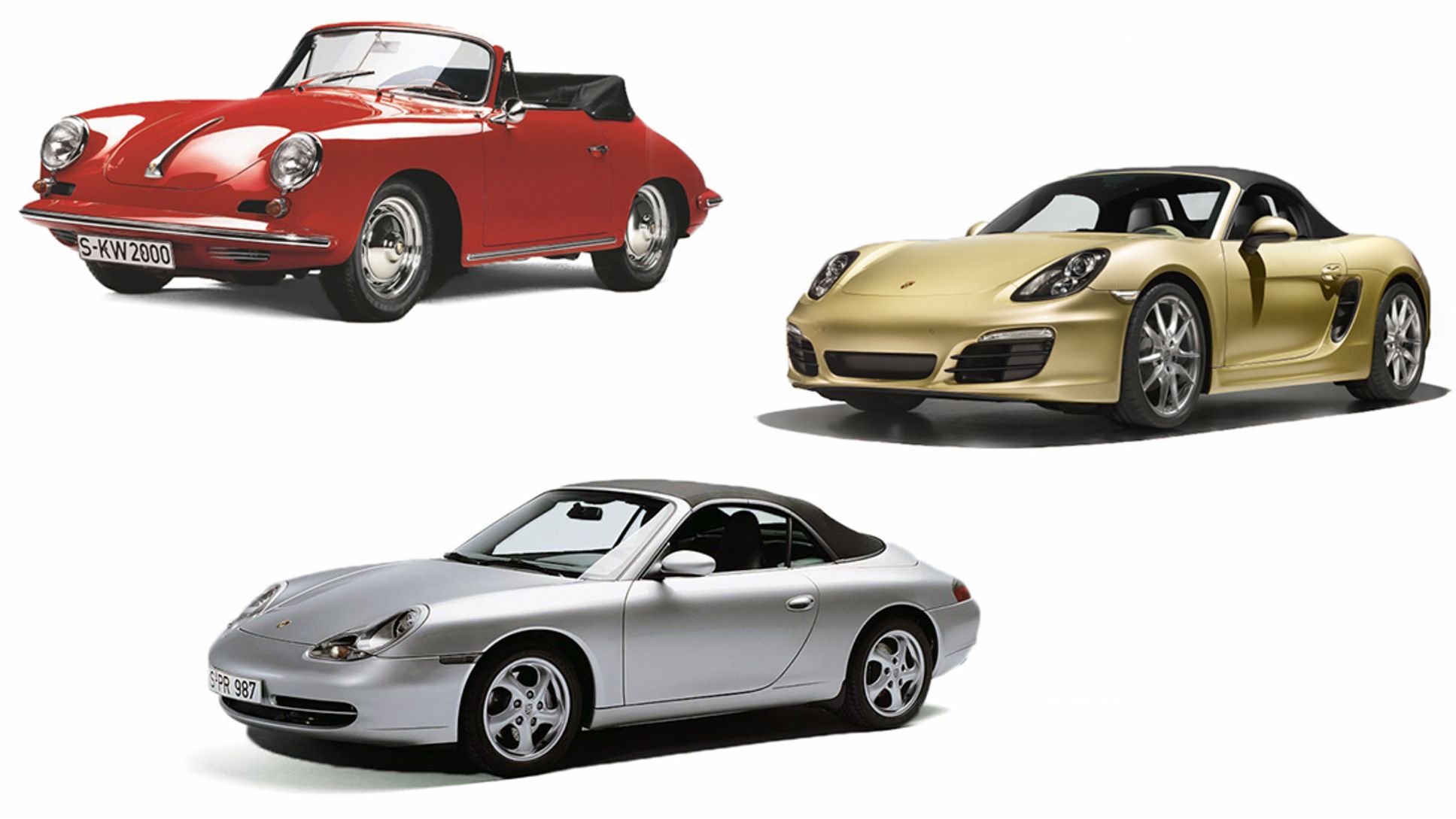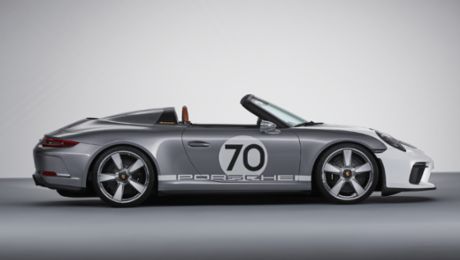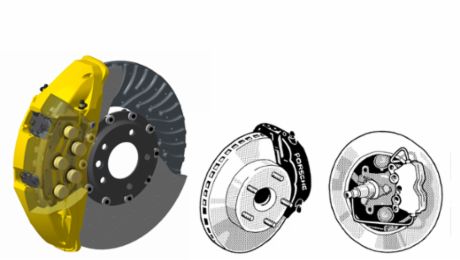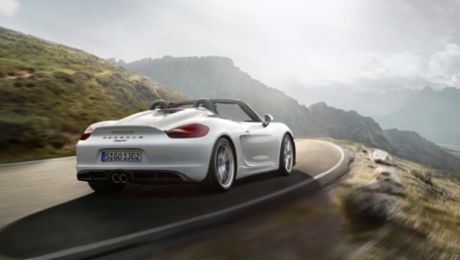The first Porsche was a cabriolet: Porsche number 1, the mid-engine roadster designed by Professor Dr. Ing. h.c. Ferdinand “Ferry" Porsche, had two open-air seats and a rain cover for poor weather. Its convertible top was a canvas piece that just fit, with a simple rod system. It was only used when it rained. Otherwise, Ferry Porsche and his co-workers preferred to drive with the top down from the workshop in Gmünd, Austria, and over their test routes. The turbulent winds that rushed over the two-piece windscreen and into the cockpit were actually pretty tame from today's perspective: number 1 had an engine power of 35 hp.
The 356 came along with the conventional top
At the onset of production of the 356 car, Porsche had moved the flat engine to the rear and produced the cabriolet alongside the coupé. Meanwhile, Porsche engineers had not only advanced the vehicle design but the convertible top design as well: tensioned under the classic fabric top was a complex rod system made of steel links and round pipe bows with a narrow front roof frame. In contrast to the sports car convertible tops that were widespread at that time, in which the fixed rod system was assembled and then had to be covered with the actual top, the 356 offered a comparatively easy to use and sturdy folding mechanism. This way, the top could be unlatched, folded up and stowed behind the foldaway seats with just a few hand movements.
This 356 convertible top, which on account of its design is referred to as a conventional top or “K" top, has been improved from generation to generation. Although the fabric top was padded, the rods and bows were still visible in the interior. In 1958, Porsche started to offer an optional hard top with insulation. This feature significantly improved the winter comfort of the sports car with its air-cooled flat engine. In its last development stage, the 356 C Cabriolet was built well into the 1965 model year, until the 911 Targa assumed the role of the convertible 911 sports car for 17 years, starting in 1965.
1987: Electro-hydraulic roof drive boosts operating convenience
In 1983, the trend-setting 911 SC Cabriolet had its debut. Though its innovative convertible top had a conventional folding system, 50 percent of it was made of pressed sheet steel sections. This ensured dimensional stability even at high speeds as well as better protection in the event of a crash. A high level of manufacturing precision and a sophisticated system of tightening and support straps guaranteed that the top would not balloon out even at speeds well over 200 kph. The new full cabriolet took the hearts of customers by storm and did so well that it almost soared past the coupé in sales figures. To boost its operating convenience even further, in 1987 Porsche developed an optional electro-hydraulic roof drive, which made the handling of the 911 convertible even easier: at the press of a button, the top opened or closed completely in a record time of 20 seconds – that included latching at the front window. In 1993, the next and final development stage of the conventional Porsche convertible top followed that was used in the 993 model range of the 911. The fabric top was completely reworked – the rear section was even flatter. The result was that the Cabriolet looked even sportier when the convertible top was up.
1996: Porsche pioneers with the Z-fold
In 1996, Porsche was the first car manufacturer to introduce the Z-fold for production cars: the new second model range, the Boxster, was given a roof with revolutionary kinematics. The new convertible top is folded in the shape of a Z and stowed in the top stowage box such that the outside of the top becomes an exterior surface after opening. Unlike conventional convertible top mechanisms, which have the top stowed with the inside turned out, this has the advantage that the top protects itself from dirtying when open; in addition, it is stowed at a low height, and the stowed-away convertible top blends perfectly in with the body shape. The new roof construction also for the first time allowed for large areas of the top to be covered with an interior roof liner. With the electric drive, the top could be quickly opened and closed in only twelve seconds.
Two years later, the convertibles of the new 911 generation (996 model range) followed with an even more sophisticated roof technology. On account of the larger roof over the two-plus-two seats, the rod system of the top had one link more than in the Boxster. The front part of the roof, between windscreen and first bow – at the B pillar – was stretched over a lightweight but stable magnesium frame. A plastic plate inserted between exterior fabric and inside roof liner provided noise protection and heat insulation. All in all, the substructure of the fabric top consisted of 32 elements. The technicians focused on lightweight construction and stability when they selected the materials. They used forged steel parts in all places where high strength was required, while saving weight through the use of aluminum and magnesium elements elsewhere. This construction made the roof light yet extremely stable. The convertible top was tested in the wind tunnel at 337 kph – with no complaints. The heatable rear window was, for the first time, made of glass. So having the car cleaned at a car wash became an option, even though Porsche did not recommend it at that time.
With electric and hydraulic actuation, the roof could be opened and closed in only 21 seconds when stationary. However, it was also possible to open it while driving at a speed of up to 50 kph. Even at 50 kph, the complete sequence of movements took only 26 seconds. An electric motor took care of folding out or folding in the rear cover that had replaced the tarpaulin, which hitherto had to be buttoned by hand.
Best technology, best look: Panel bow top
The zenith of convertible top technology for the time being was reached two years ago when Porsche launched the latest version of the 911 Carrera Cabriolet: The eye-catcher of the 911 Carrera Cabriolet is no doubt the unparalleled panel bow top. This innovative technology has made it possible to realise a previously unattainable coupé-like roof arch of the fabric hood when it is up, which offers aerodynamic benefits as well. The panel bows and top are not joined to one another, so that when the top is lowered the four identically shaped magnesium segments nest on top of one another, while the fabric top is stowed away in the tried-and-tested Z-fold. Owing to this unique design, the opened convertible top package requires minimal installation space. Inside, the roof segments are covered with dimensionally stable roof liner panels that create a cosy interior atmosphere. The lateral parts are also completely covered with fabric so that neither the bows show under the fabric nor are there any sections that disrupt the flowing design. Never in the history of the 911 have the convertible and the coupé been so alike.
Comsumption Data
911 Carrera Cabriolet: Combined fuel consumption: 9.2 – 8.4 l/100 km; CO₂ emission: 216 – 195 g/km



